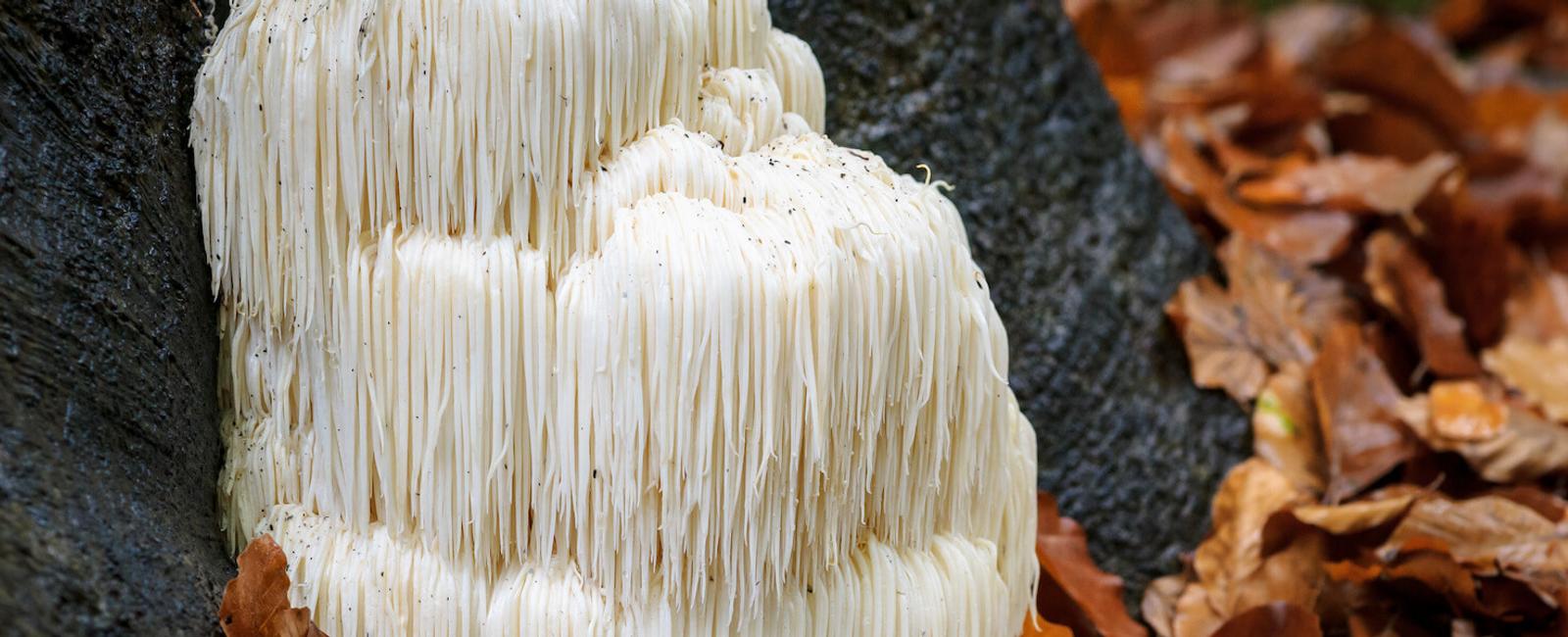

Lion’s mane mushrooms are certainly one of the most unique-looking species of fungi. Their distinctive clump of short, soft spines makes them an instant eye-catcher for amateur and veteran mycology enthusiasts alike.
Yet, their popularity doesn’t only stem from their looks—these amazing mushrooms have been used for centuries as a medicinal tool for treating all sorts of ailments. From managing tumors to protecting brain health, lion’s mane are among the best functional mushrooms worldwide. Here’s what you need to know.
What are lion’s mane mushrooms?
Lion’s mane mushroom, scientifically known as Hericium erinaceus, is an edible fungus native to Europe, Central and North America, and Asia. Known for its unique appearance, lion’s mane is considered an absolute delicacy and a valuable medicinal mushroom. Lion’s mane is also known as:
- Bearded tooth mushroom
- Bearded hedgehog
- Mountain-priest mushroom
- Monkey’s head mushroom
H. erinaceus is the only mushroom species that grows as a clump of dangling spines. While there are other fungi that form spines (such as Lycoperdon echinatum), lion’s mane mushrooms are the only ones that don’t show branches or traditional-looking fruiting bodies.
Luckily, the spines are soft and won’t hurt if you grab a specimen with your bare hands. In fact, lion’s mane are so mushy and spongy that you can cut them into pieces without using knives or scissors.
Lion’s mane mushrooms are usually found in wounded or recently dead hardwoods, such as oaks. They’re considered to be wood-rot fungi but are also parasitic, meaning they can thrive off living trees. They mostly appear from late summer through fall, but they may also grow during winter and spring in warmer climates.
H. erinaceus has become increasingly popular in recent years. Its sweet aroma, soft texture, and lobster-like flavor make it a unique but versatile addition to any kitchen. Plus, it’s often sold in powder and capsule form as a mushroom supplement—an ideal choice for people who only want to reap its medicinal benefits (1) (2).
How do lion’s mane mushrooms look?
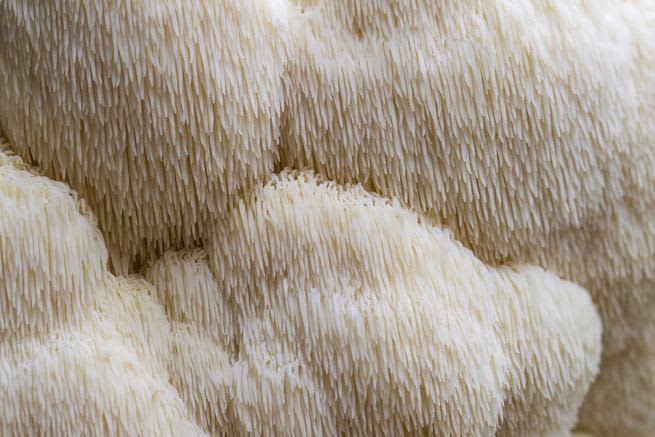
Lion’s mane mushrooms form a dense blob or clump of hanging spines that measures 8–24 cm (3.1–9.4 in) across. The spines themselves measure 1–4 cm long (0.4–1.5 in), are usually white in color, and show a hairy appearance. However, the fungi will turn light brown or yellow with age—especially on the top.
Beneath this clump is a hidden base strongly attached to the tree or log the fungus is growing on. Its spore print is completely white. A key aspect of identifying lion’s mane is that it’s the only species that only grows a single clump of spines. Other similar fungi develop branches that connect several blobs (1).
What are the varieties of lion’s mane mushrooms?
There aren’t any known varieties of lion’s mane mushrooms. But this wasn’t always the case. Previously, before the current definition of H. erinaceus was adopted, scientists recognized three different varieties:
- Hericium erinaceus var. erinaceus
- Hericium erinaceus var. sulphureum
- Hericium erinaceus var. viridescens
However, these three varieties are now considered obsolete and are classified as synonyms for the common H. erinaceus (previously known as var. erinaceus). The same thing happened to two subspecies (subsp. erinaceo-abietis and subsp. unguiculatum) (3) (4).
The only strains officially recognized by mycologists only show technical differences in growth parameters. These are usually named with very specific terminologies, such as “ATCC #62771”—so it’s almost impossible to come across them unless you’re an experienced fungi cultivator (2).
History of lion’s mane mushrooms
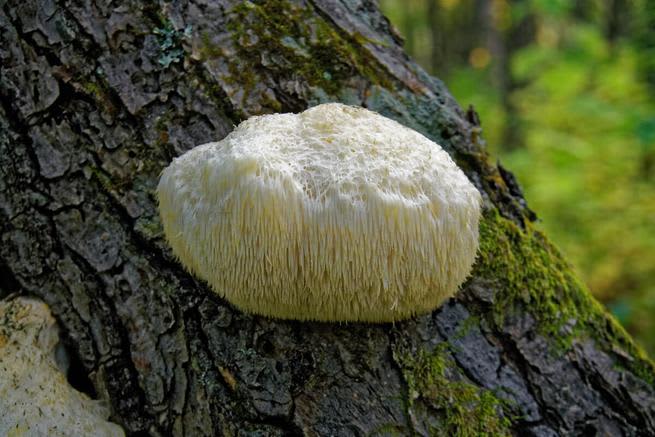
Unfortunately, there aren’t any clear resources describing the history of lion’s mane mushrooms. Still, we know that these fungi have been around for thousands of years and that humans have used them since ancient times for food and medicine.
Experts suggest that H. erinaceus is particularly prevalent in Ancient Chinese medicine, with literature indicating that they called it “yamabushitake.” Traditional Japanese populations also seemed to use this species, calling it “hóu tóu gū” (meaning monkey head mushroom).
In both cultures, lion’s mane was used to fortify the spleen, combat cancer, and promote gut health. There’s also some evidence indicating that it was used to treat Qi deficiency in traditional Chinese medicine—which corresponds to ailments such as insomnia and weakness (5) (6) (7).
As for its taxonomical history, we know that it was first described by Jean Baptiste Bulliard in 1781. German mycologist Christiaan Hendrik Persoon later fully completed this description in 1797 (4).
Health benefits of lion’s mane mushrooms
Lion’s mane mushrooms are among the most beneficial fungi in the world. They are considered a functional mushroom—species that offer significant wellness and nutritional values. As one of the market’s most popular mushroom-based supplements, there’s a lot to break down here.
Regarding the nutritional benefits of lion’s manes, they contain 57% total carbohydrates, 3.50% total fat, and 22% total protein. This macronutrient balance makes them the perfect addition to almost any diet—particularly those of vegetarians or vegans looking to replace meat. Furthermore, they also provide several micronutrients, including (8) (9):
- Potassium
- Phosphorus
- Magnesium
- Vitamin D
- Vitamins from the B complex
As for the health benefits, lion’s manes are mainly known for their ability to protect and stimulate the nervous system and brain health. A comprehensive 2013 review went over several studies on the topic, concluding that the species could help manage and improve dementia, mild cognitive impairment, depression, and anxiety.
The authors theorize that these benefits could be related to a compound called myelin, which wraps around neurons and provides support and isolation—so damage in these structures could lead to severe consequences in brain function. In turn, H. erinaceus could help promote the genesis and growth of myelin (6).
A 2016 paper further supports this theory and states that the mycelium of H. erinaceus could delay neuronal cell death. This could be useful for managing conditions that affect cognitive function, such as Alzheimer’s disease. While the trials consisted of both in vitro and in vivo animal studies, the authors conclude that, with more research, these benefits could translate well into humans (10).
Another possible effect of lion’s mane mushrooms is their anti-cancerous activities. The polysaccharides from H. erinaceus could modulate and stimulate the immune system, inhibiting tumor growth as a result. Those same polysaccharides have also shown significant anti-fatigue and antioxidant activities (6) (8).
Several other benefits stem from using lion’s mane mushrooms, including lowering blood sugar levels, managing ulcers and gastritis, and protecting heart health. While most of these benefits come from polysaccharides, there are other beneficial bioactive compounds in this species, such as hericenones and erinacines (8).
Still, it’s important to remember that more research is needed to confirm these benefits. While these preliminary studies are very promising, almost all papers conclude that stricter clinical trials that include placebos and double blinds are necessary. But if these benefits were to be confirmed, lion’s mane extracts could be a powerful and valuable tool for healthcare professionals.
Are there any side effects to lion’s mane mushrooms?
Luckily, experts suggest that H. erinaceus is safe for most people. The dosage needed to cause adverse effects is almost unreachable. Plus, a clinical trial studying the effects of lion’s mane on 36 patients concluded that every participant was able to tolerate the mushroom (10).
Where do lion’s mane mushrooms grow?
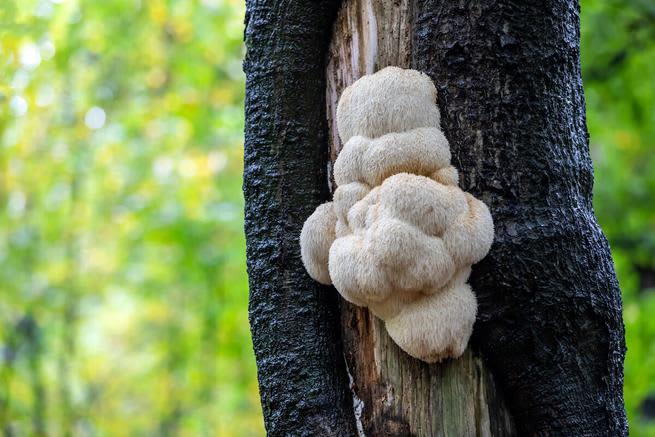
Lion’s manes are widely distributed worldwide, including North and Central America, Europe, and Asia. They seem to strongly prefer the temperate and tropical climates of the southern United States, where they are most abundant.
The mushroom grows on dying or dead hardwoods, including oak, walnut, maple, and beech. Usually, bearded tooth mushrooms appear on fallen logs or stumps—but they may also grow on live trees, especially near wounds. This makes it both a wood-rot and a parasitic fungus.
It’s common to find specimens growing alone, but they may also grow in pairs. They fruit from late summer through fall. However, they may also grow during winter and spring in warmer climates (1) (2).
Lion’s manes are easy mushrooms to grow at home if you have an outdoor area. You only need to inoculate a hardwood log with H. erinaceus spores and bury it partially into the ground. If you’re lucky, the log will take years to fully decompose, providing you with several lion’s mane yields in the meantime (2).
What is ethical wildcrafting?
Ethical wildcrafting refers to the practice of harvesting natural resources without damaging the environment. Wildcrafting is sometimes confused with foraging—the critical difference is that foraging refers to harvesting for eating, and wildcrafting is for medicinal purposes.
Wildcrafting natural resources like lion’s mane mushrooms without care can damage not only that species but also the others living in that ecosystem. As such, here are some basic guidelines that can help you keep your local fungi populations thriving:
- Take your time before heading out to research local endangered or poisonous species, as well as possible lookalikes.
- Harvest only what you need—don’t overstock as it can damage the mushroom patch.
- Don’t disclose patch locations to anyone.
- Pick the fruiting bodies carefully, either with your hands or with a small knife.
- Ask for permission from the landowner if you’re harvesting on private land.
- Check local harvesting laws (if harvesting on public land).
If you’re new to harvesting but still want to ensure you don’t damage the environment, try to find a local harvesting group. These communities will gladly teach you the basics of ethical wildcrafting and keep you safe from picking toxic lookalikes.
Is it safe to wildcraft for lion’s mane mushrooms?
It’s never 100% safe to consume wild-picked mushrooms, be them lion’s manes or any other species. Harvesting fungi from nature always carries the risk of confusing your desired species with a toxic lookalike. However, the two most common lion’s mane lookalikes (H. americanum and H. coralloides) are edible.
Another risk of eating wild-picked lion’s manes is environmental pathogens. Wild fungi often carry toxins from their ecosystem, which may lead to indigestion and other gastric problems.
How do you take lion’s mane mushrooms?
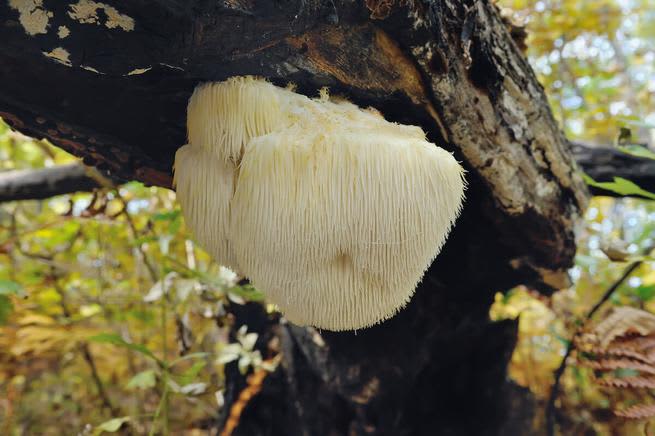
Lion’s mane mushrooms can be eaten dried, cooked, or raw. They are a versatile option that add a unique touch to any recipe while providing dozens of health benefits. Plus, their seafood-like taste makes them a perfect choice for replacing fish or shellfish.
As with most other fungi, you can cook lion’s manes in various ways, including simmering, boiling, roasting, and sauteing them. A great way to bring out the lobster flavor is to cook them in canola oil and add some butter before taking them out of the pan.
You can then add the cooked mushrooms to almost any dish you can imagine—from salads and stews to pizza and risotto. H. erinaceus is also perfect for combining with other mushrooms, such as pink oysters, white buttons, and shiitakes.
However, if you’re only looking to use lion’s manes for medicinal purposes, it’s also possible to find them as a dietary supplement. Usually, lion’s mane supplements come in powder, capsules, tablets, and tinctures. Many of them also contain other medicinal mushrooms, such as reishi and chaga.
It’s important to remember that none of these supplements are 100% approved by the scientific community. As such, there aren’t any exact dosages or safety measures for taking lion’s mane mushroom extracts.
Lion’s mane mushrooms: Unique-looking wonders
Lion’s mane mushrooms are among the most popular and beneficial functional fungi in the world. Native to Asia, America, and Europe, they’re known for their distinctive clump of short spines. While most people choose to eat them, it’s also possible to find them in powder, capsule, and tincture form as dietary supplements.
Ready to learn about other types of mushrooms? Keep up on shroomer! Here, you’ll find all the details you need about psychedelic and functional fungi from all over the world, along with the latest news on medicinal research on edible mushrooms.
References
- Kuo, M. “Hericium erinaceus.” MushroomExpert.com (2022). http://www.mushroomexpert.com/hericium_erinaceus.html
- Paul Stamets. “Hericium erinaceus (Bulliard: Fries) Persoon.” in Growing Gourmet and Medicinal Mushrooms (1993): 338–394.
- Catalogue of Life. “Hericium erinaceus (Bull.) Pers.” (No date). https://www.catalogueoflife.org/data/taxon/3KYXV
- MycoBank. “Hericium erinaceus.” (No date). https://www.mycobank.org/page/Name%20details%20page/12801
- Kevin Spelman, Elizabeth Sutherland, Aravind Bagade. “Neurological Activity of Lion’s Mane (Hericium erinaceus).” Journal of Restorative Medicine 6(1) (2017): 19–26. https://restorativemedicine.org/journal/neurological-activity-lions-mane-hericium-erinaceus/
- Md. Asaduzzaman Khan, Mousumi Tania, Rui Liu, Mohammad Mijanur Rahman. “Hericium erinaceus: an edible mushroom with medicinal values.” Journal of Complementary & Integrative Medicine 10 (2013). https://doi.org/10.1515/jcim-2013-0001
- Takashi Mizuno. “Yamabushitake, Hericium erinaceum: Bioactive substances and medicinal utilization.” Food Reviews International 11(1) (1995): 173–178. https://doi.org/10.1080/87559129509541027
- Sławomir Sokół, Iwona Golak-Siwulska, Krzysztof Sobieralski, Marek Siwulski, Katarzyna Górka. “Biology, cultivation, and medicinal functions of the mushroom Hericium erinaceum.” Acta Mycologica 50(2) (2015). http://dx.doi.org/10.5586/am.1069
- FoodData Central. “Mushrooms, lion’s mane.” October 2021. https://fdc.nal.usda.gov/fdc-app.html#/food-details/1999626/nutrients
- I-Chen Li, Li-Ya Lee, Tsai-Teng Tzeng, Wan-Ping Chen, Yen-Po Chen, Young-Ju Shiao, Chin-Chu Chen. “Neurohealth Properties of Hericium erinaceus Mycelia Enriched with Erinacines.” Behavioural Neurology (2018). https://www.ncbi.nlm.nih.gov/pmc/articles/PMC5987239/


